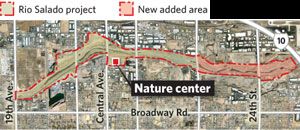

|
I should check this out!!! It looks like a nice place for homeless people to live.
It is along the Salt River between I-10 (east of 24th Street) to 19th Avenue!
Last leg of Rio Salado habitat to be completed today in Phoenix Green carpet rolls out today for last leg of park by Jahna Berry - Apr. 23, 2009 12:00 AM The Arizona Republic The Rio Salado habitat project, just south of downtown Phoenix, is a hidden jewel of nature that attracts egrets, ospreys and more than 200 other bird species - but relatively few people. That may be about to change after today, when the city opens the final 1.5 miles of the riverside habitat and prepares to unveil a new nature center. The once-dry river, which had been a dumping ground for industrial businesses along its banks, is a symbol of renewal. The $100 million, 600-acre park, which envelops the Salt River from 19th Avenue to 24th Street, is an oasis of cottonwood trees, marshes, waterfalls and trails just as the city envisioned more than a decade ago. The first part of the habitat-restoration area, between 19th Avenue and 16th Street, opened in 2005. Today, the parkland between 16th and 24th streets will open to the public. "What we have been able to do is take this underutilized riverbed and create a public amenity," said Karen Williams, a deputy parks director, adding that $500 million in commercial and housing development has been built within 7 miles of the park since 2000. "It's a wonderful amenity for the public and wildlife, and it can be a trigger for development," she said. Under the guidance of the U.S. Army Corps of Engineers, crews have removed tons of trash, planted thousands of trees and built more than 20 miles of trails that wind throughout the area. In June, the National Audubon Society plans to open a $4 million, 7,500-square-foot nature center near Central Avenue. The center could draw up to 10,000 children a year to the banks of the Salt River, officials from the conservation group say. Park officials hope the restored habitat and nature center will attract more Valley residents to the park, which was paid for by federal funding and by the Maricopa County Flood Control District, city bonds, grants and donations. Riparian habitat beside rivers and streams is vanishing in Arizona because dams reduced river flows, said Walt Kinsler, project manager for the Rio Salado Habitat Restoration Area. "In Arizona, 90 percent of wetland and riparian areas have been lost in the last 100 years," he said. Looking for visitors The Rio Salado park contains habitat that exists only in a handful of areas in the world, as development has damaged similar nature in other countries, Kinsler said. The park attracts 200 kinds of migratory birds and other wildlife, offering them a place to feed and rest. But relatively few people take advantage of it, park officials say. Although the habitat-restoration area has quadrupled the number of visitors it had during its first year, attendance numbers are still "modest," said Heather Wasgatt, natural-resource manager. About 20,000 people visit each year, a small number compared with other city parks. South Mountain Park, for instance, attracts 1.5 million to 2 million visitors annually, and hundreds of thousands of hikers hit the summit trail of Piestewa Peak each year, Wasgatt said. "The word is getting out," she said. "(But) because we are a new area, it's taken a longer period of time to educate the public that we have transformed from a dry riverbed to a riparian area with recreational opportunities." On a recent morning, a dozen birdwatchers walked quietly down a tree-lined trail in the heart of the habitat. Egrets flew up around them and hummingbirds flitted among the trees. "Do you hear that sweet, high-pitched voice?" asked Tom Gaskill, a volunteer who leads bird walks. "That's a yellow warbler," he said. After the walk, Phoenix resident Ginny Brouch gushed about the park. "This is a jewel," said the 70-year-old retired teacher, who came to the bird walk with several other retired teachers. "I will come back." Enticing kids When the nature center opens, it will help attract even more families, Kinsler said. "It will add another anchor," he said. "The more kids that we can get down there, that will help plant the seed that they will tell their parents." The Audubon center will occupy 4 acres at the southeastern corner of Central Avenue and the Salt River. The $4 million Nina Mason Pulliam Rio Salado Audubon Center was financed with grants, private donations and $1 million from city bonds. The National Audubon Society has 80 centers and sanctuaries around the U.S. that have historically been built in rural areas. Audubon chose Phoenix for the nature-center site because the group wants to reach out to people who live in cities, said Sam Campana, executive director of Audubon Arizona, state office of the 100-year-old national group. The project will bring exhibits, programs and events for people of all ages to the park, Campana said. Admission is free. The Rio Salado habitat offers a unique opportunity to teach visitors about water conservation, river systems and environmental issues, said Sarah Porter, associate director of Arizona Audubon office. "How people use water in Phoenix impacts the habitat," she said. |